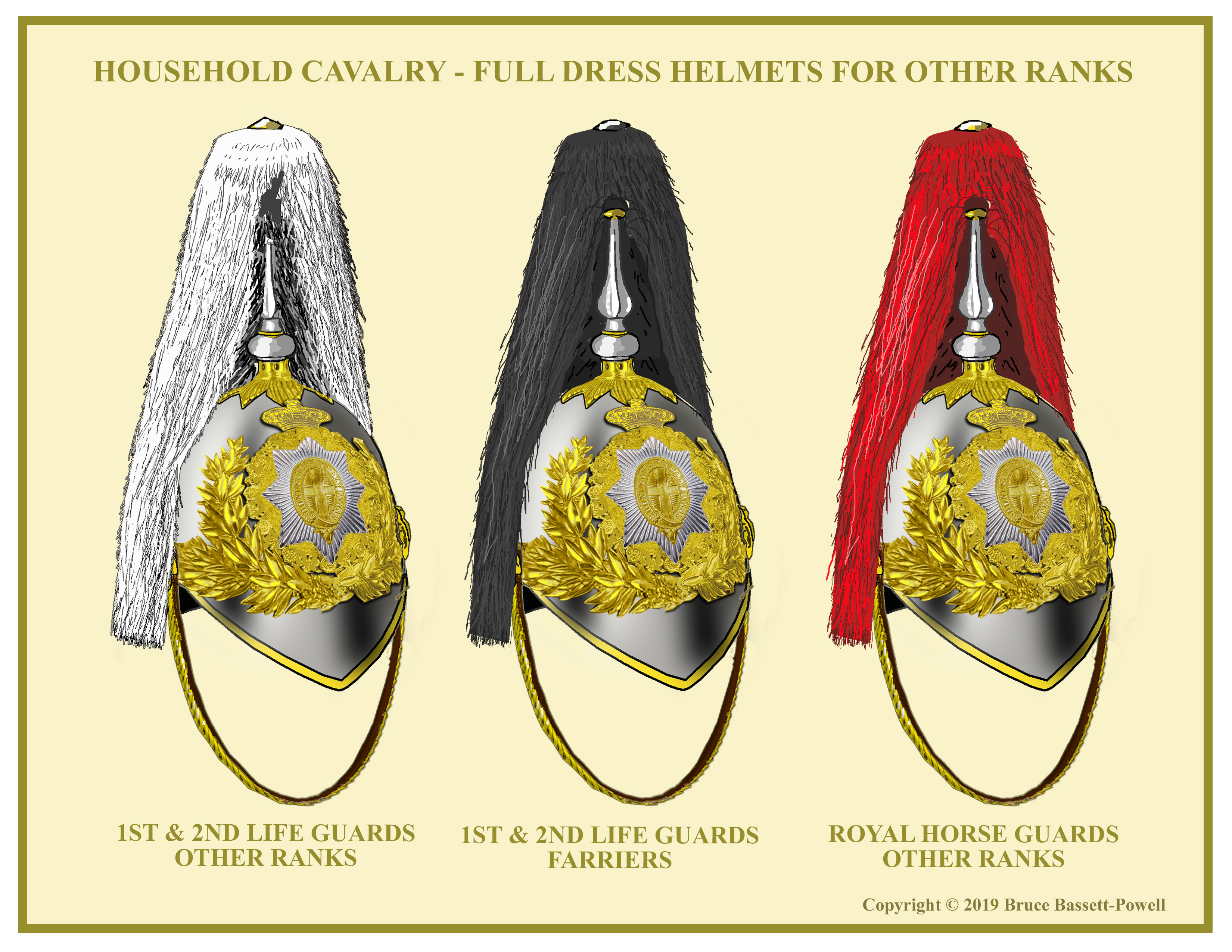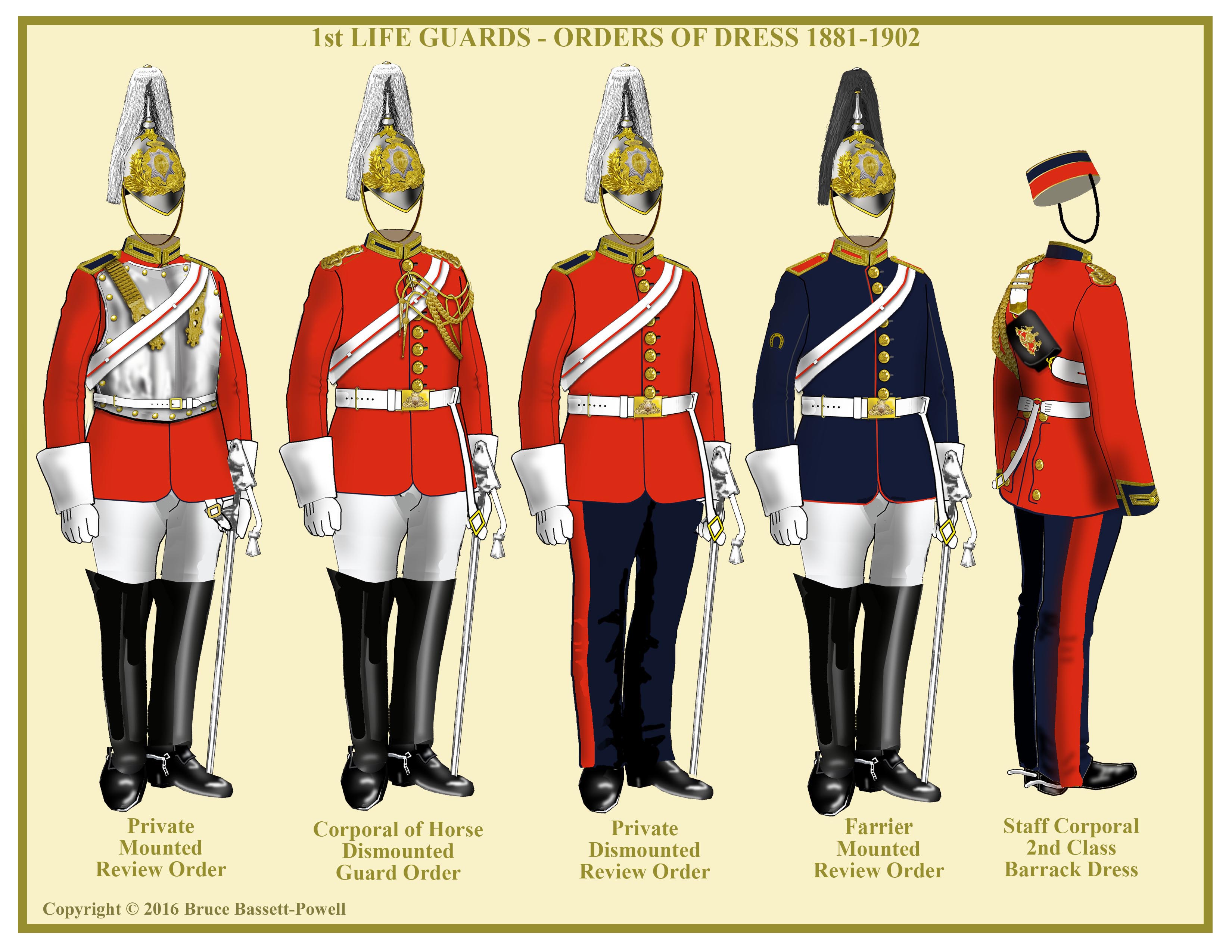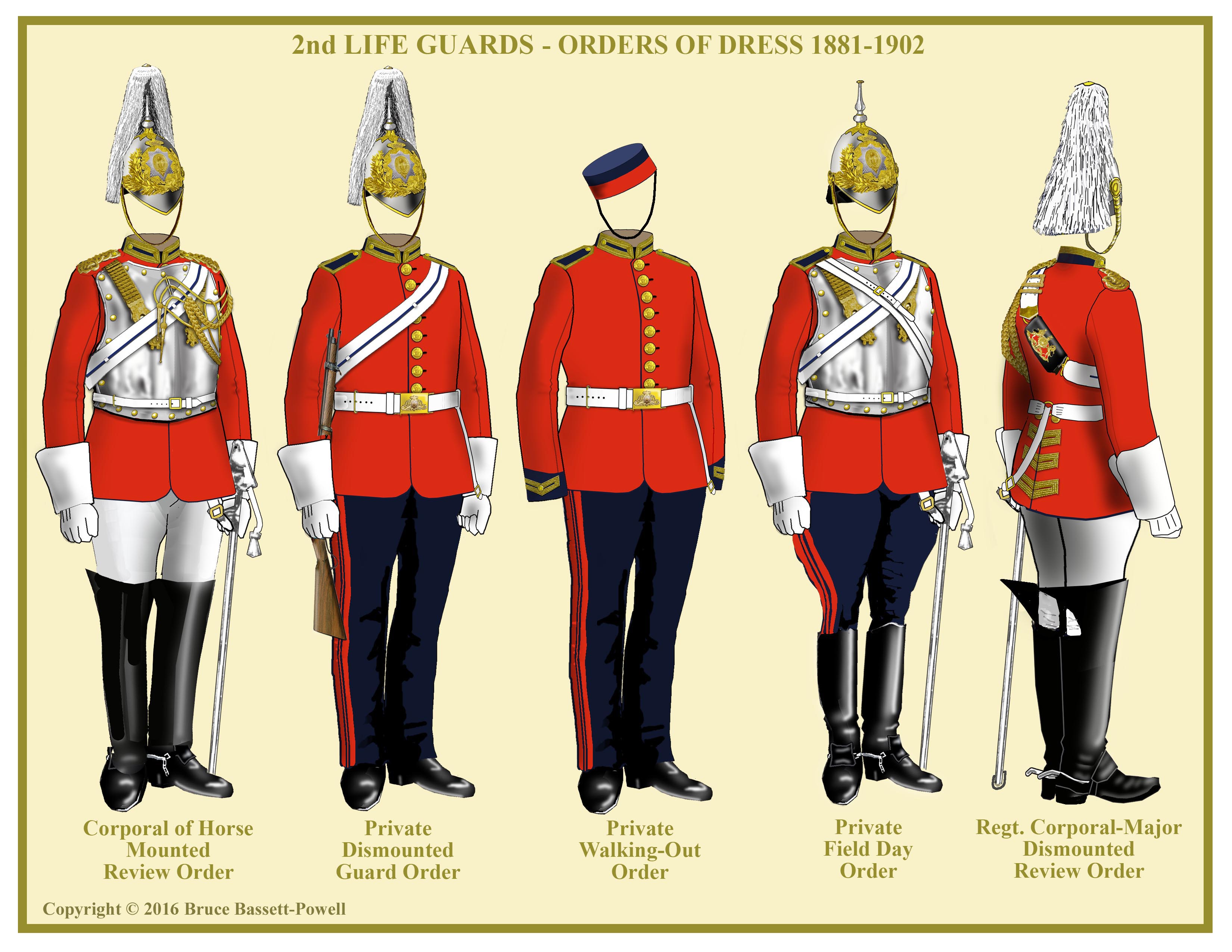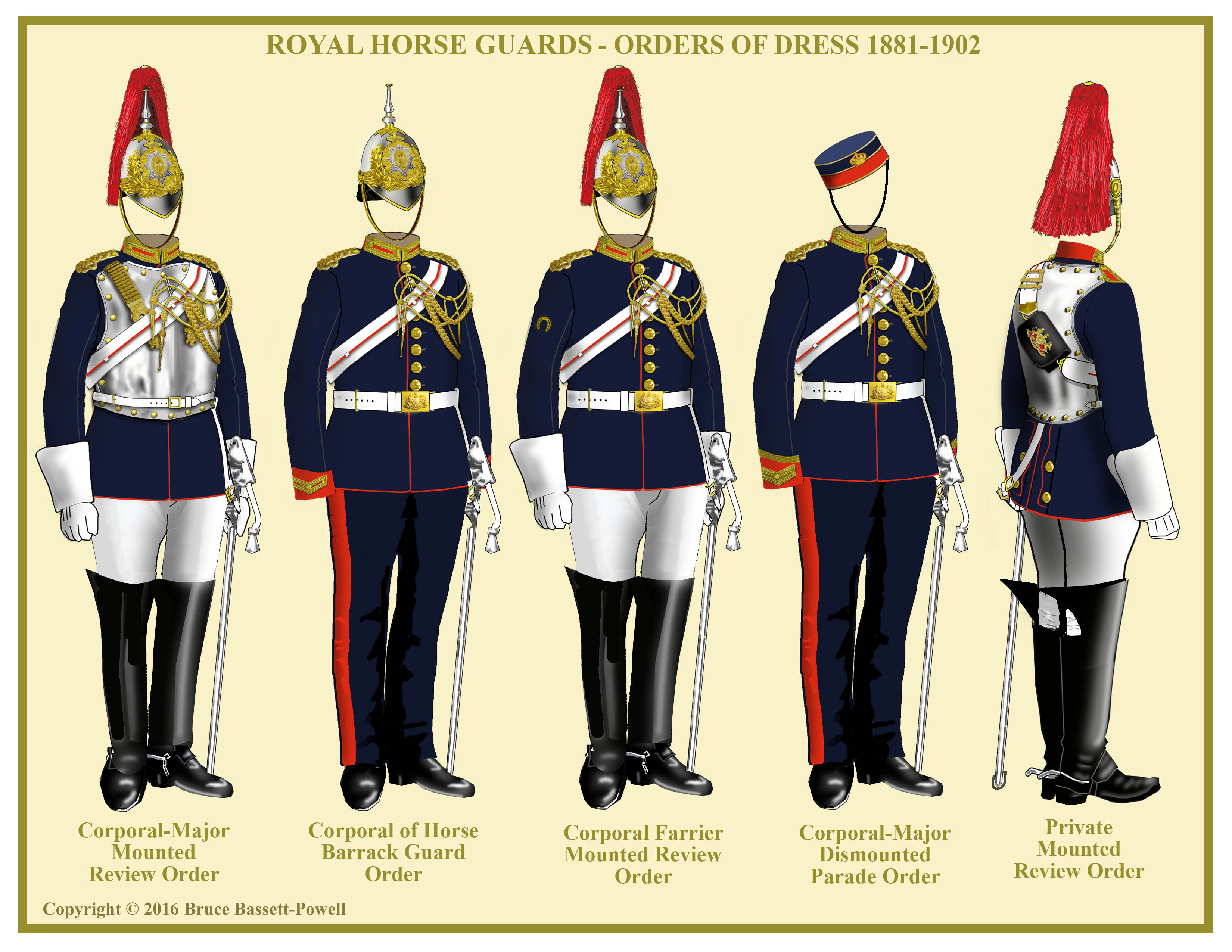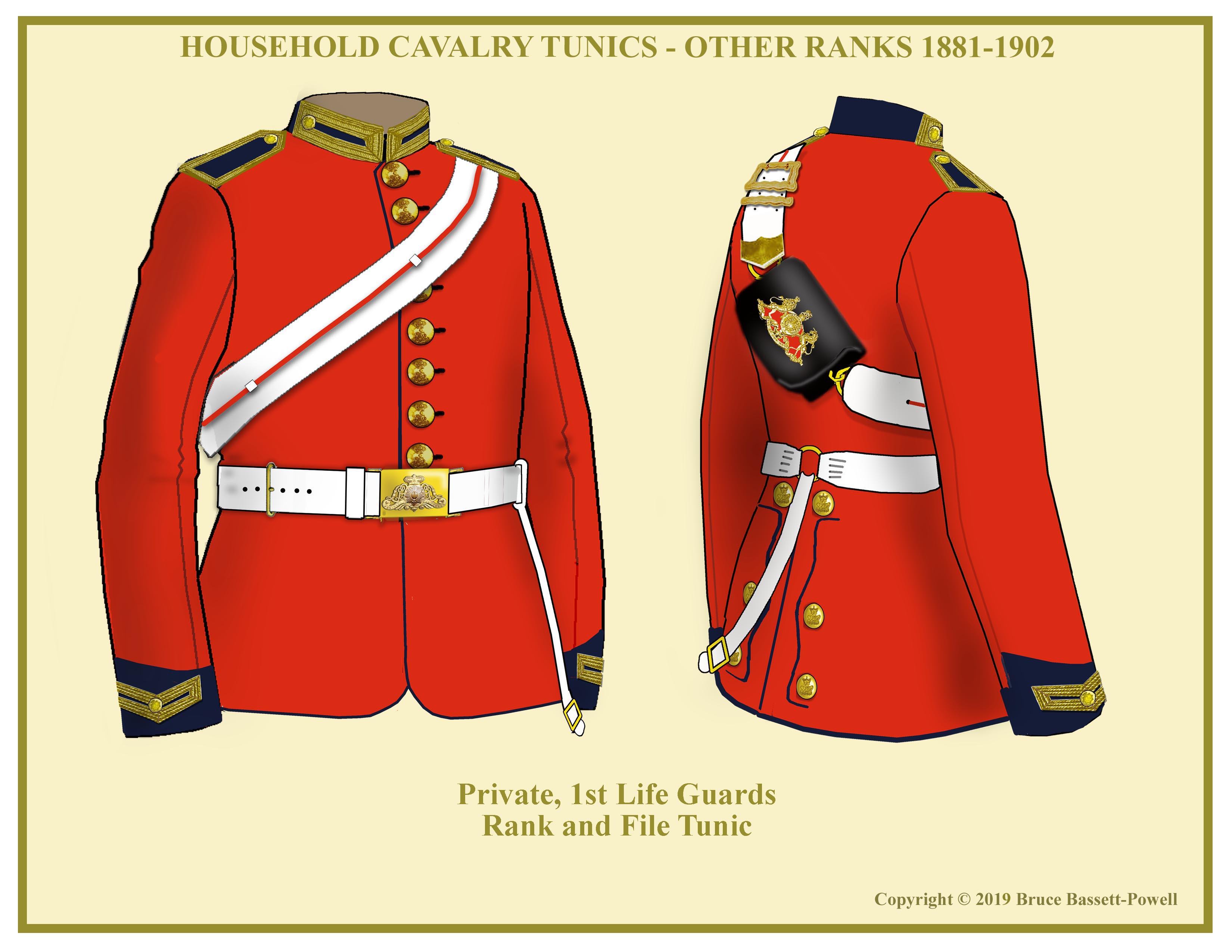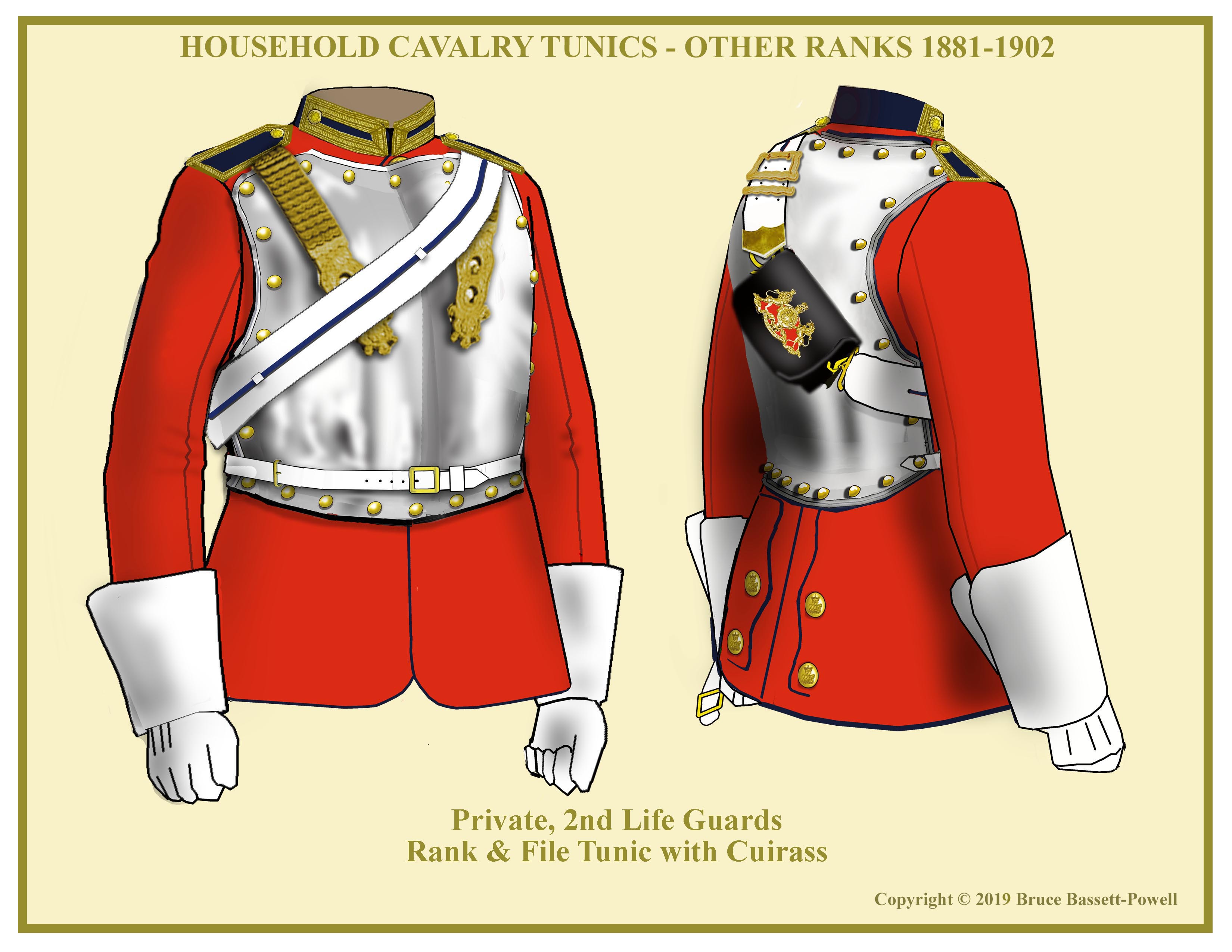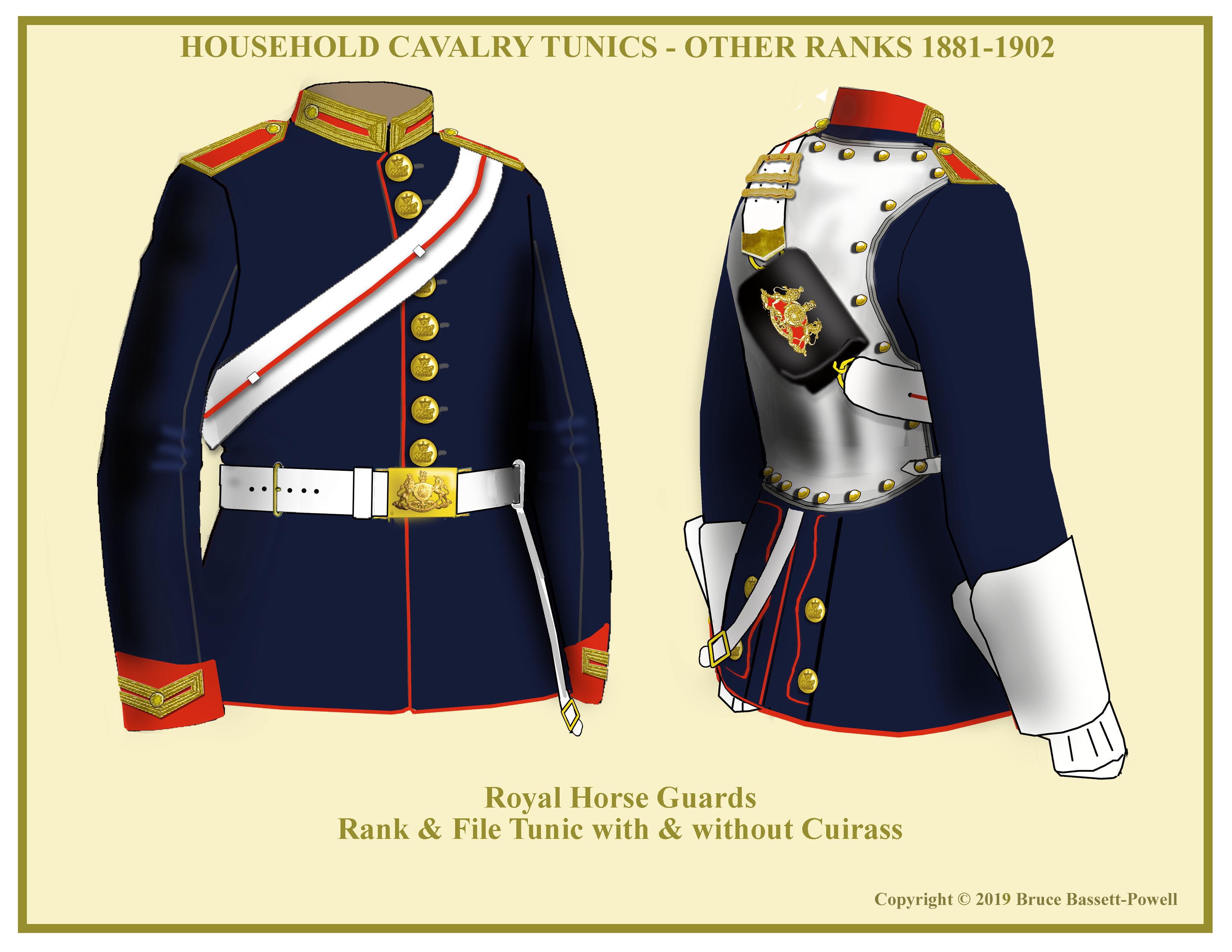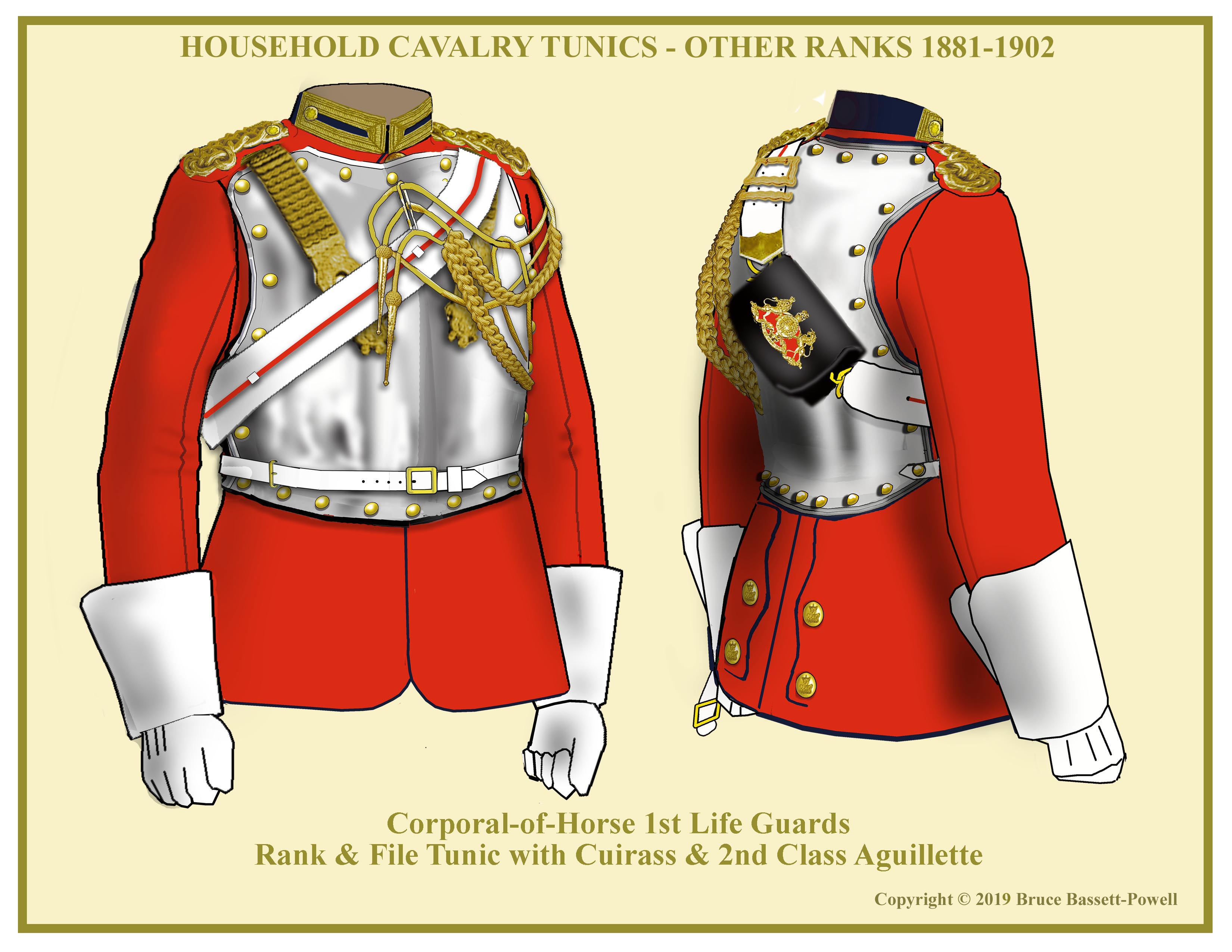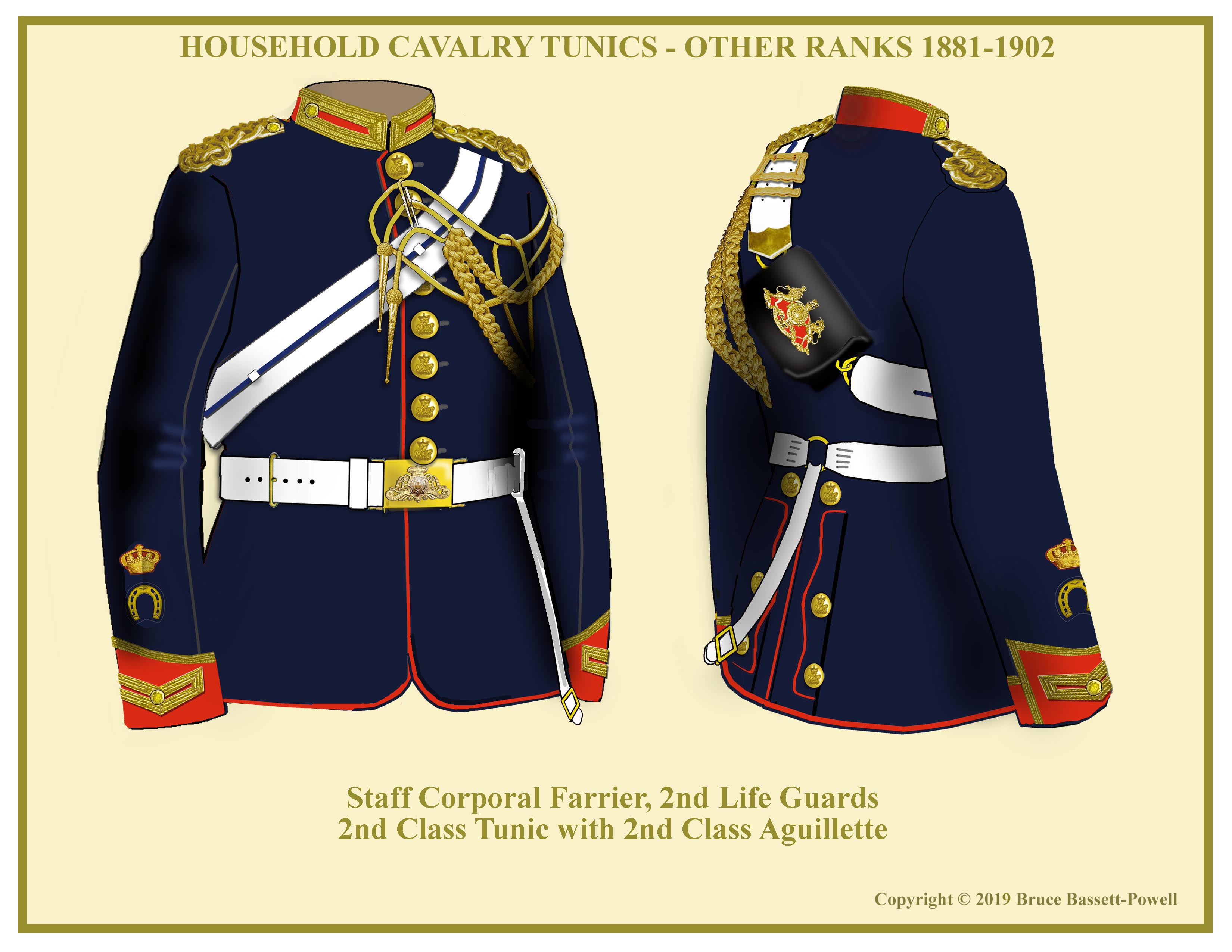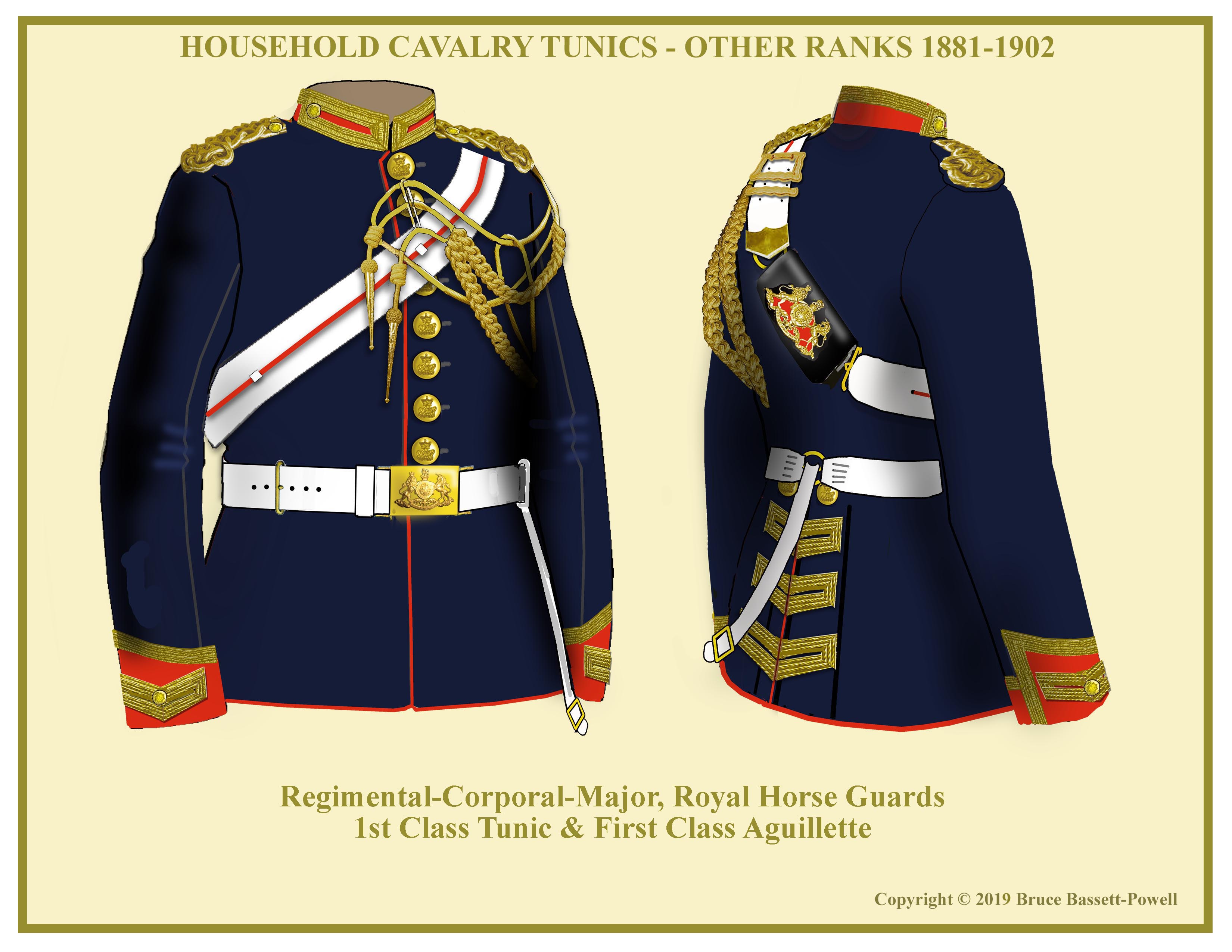UNIFORMS OF OTHER RANKS
UNIFORMS, ARMS & EQUIPMENT - HOUSEHOLD CAVALRY
UNIFORMS
In contrast to the uniforms of the regular cavalry, those worn by Household Cavalry presented a much more complicated and arcane appearance.
The Tunic
In general, the tunics of all three regiments were the same with the 1st and 2nd Life Guards being scarlet with dark blue facings and the Royal Horse Guards wearing dark blue with scarlet facings. The tunic was piped all round with facing colour cloth and up the rear slit on the skirt. On the collar a flat squared loop of ½” gold lace on each side ending in line with the shoulder strap buttons. The shoulder straps were edged all round in the same gold lace. On the gauntlet shaped cuffs was a loop in the form of a chevron in the centre. On the ends of the collar and on the point of the cuff chevrons there was a small regimental button. On the rear skirts there were two buttons at the waist and on each side of the central slit a three cornered flap edged in facing coloured cloth. There was a button on the centre and bottom points (The flap edging was somewhat more rounded than usual. Regimental differences were; the 1st & 2nd Life Guards had rounded edges on the front tunic skirts while the Royal Horse Guards had square edges. Also, the collar on the 1st Life Guards was square, while the 2nd Life Guards had slightly rounded collars. This is known as the Rank and File tunic.
The Cuirass.
This was essentially the same as for the officers. The steel halves were secured at the shoulder by brass scales attached to studs on the front plate. A white belt attached to studs on the bottom corner edges of the rear plate was secured by a buckle in front.
Rank Distinctions.
The Household Cavalry did not wear chevrons on the dress tunic and crowns were only worn above trade badges by Staff ranks. The term “Sergeant” was (and still is) never used and replaced by “Corporal”*. For privates, trade badges such as farrier, saddler or rough-rider were worn on the right upper sleeve. For corporal instructors and above, the badges were worn on the lower right sleeve surmounted by a Guelphic Crown. Chevrons, points up for good conduct were worn by privets on the lower left sleeve. Qualification badges for signallers, marksmen and swordsmanship were worn above these on the lower left sleeve. Below are the full dress distinctions as they were worn:
Corporal and Corporal-of-Horse:
Rank and file tunic with plaited gold shoulder cords instead of shoulder straps. On the left shoulder, a Second Class aiguillette attached to the shoulder cord looping up to the top button. From this button depended a “needle” with a small sphere in gold which hung down to middle of the tunic.
Staff Corporals, 2nd class, (Troop Corporal-Major’s, Orderly Room Corporals, Farrier Corporals, Drill Corporals, Corporal Saddlers, Rough Rider Corporal)
2nd Class Tunic which had a ¼ inch row of lace around the top of the collar and the same around the top of the cuff and back seam. The same plaited gold shoulder cords and Second Class Aiguillette.
Staff Corporal 1st Class. (Regimental Corporal-Majors, Quartermaster Corporal-Majors, Bandmasters, Farrier Quartermaster Corporals).
1st Class Tunic which had ½ Inch lace instead of that on the 2nd Class Tunic. The gold chevrons on the cuffs was somewhat thicker and solid. On the tunic skirts were three gold chevrons, split by the central flap, getting progressively larger downwards. The 1st Class aiguillette was the same as the 2nd class with the addition of spiral knots above the spheres on the needles.
Trousers and Netherwear.
In Review Order and dismounted Guard Order, white buckskin breeches were worn. These were fairly tight and worn with the black jackboots in full dress. They were also worn with knee boots for various duties in undress (see next section). In Dismounted Review Order, Barrack Guard Order, Undress and walking out, overalls were worn. The 1st Life Guards and Royal Horse Guards had a 2 ½ Inch single scarlet stripe down the side while the 2nd Life Guards. For field exercises and later in the century for mounted undress, cavalry breeches were worn with the same scarlet stripes as worn on the overalls.
Equipment.
A full description of the Household Cavalry other ranks equipment and weapons will be in a future segment. For the purposes of this segment this brief focus will be on that used with the full dress tunic.
The sword belt had a rectangular brass plate with the same badge as on the officer’s plate only in brass. The sword slings were worn under the tunic when the cuirass was worn by the 1st & 2nd Life Guards and outside without. The sword belt was worn over the tunic bot with and without the cuirass in the Royal Horse Guards. The pouch belt, wider than that of regular regiments had a flask cord that was scarlet for the 1st Life Guards and Royal Horse Guards, blue in the 2nd Life Guards. The cord passed through two small leather loops on the belt. The pouch was the same as that worn in other regiments but with a brass Royal Arms on the flap with a scarlet cloth backing. 1st Class Staff Corporals wore the officers’ pouch with the same decoration as the other ranks.
ORDERS OF DRESS
Below are images representing the various orders of dress that included the rank and file, second class and first class tunics. Some show the undress pill box cap which will be described in the next section. Although each of the regiments has a single plate, the various orders of dress were worn throughout the regiments.
COMING NEXT
HEADDRESS
All three regiments wore the same basic helmet apart from the plumes which were white for the 1dst and 2nd Life Guards and Scarlet for the Royal Horse Guards. Farriers of the first two regiments had black plumes. The helmets were almost identical to officers except that the furniture was of brass or gilding metal. The central plate with its decorations of laurel and oak leaves was the officers’ version but the central part upon which the Garter Star was placed was not pierced but one piece. The Star itself was of white metal with the central garter and cross in brass.



